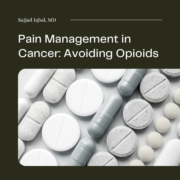Pain Management in Cancer: Avoiding Opioids
Disclaimer: Sajjad Iqbal, MD is a retired physician and rare cancer survivor who routinely supports, mentors and guides other patients through their perilous cancer journeys. Any opinions, suggestions, or advice provided is solely from Dr. Iqbal’s perspective as a well-informed and knowledgeable cancer patient, not as a physician. The patients must discuss their health with their own doctors and follow their advice.
During their long & tumultuous journey, cancer patients suffer from a multitude of very difficult and troublesome problems. Pain is perhaps the most common and debilitating one. The pain can be caused by the cancer itself, as when it erodes the healthy tissues or when it attacks the nerves or nerve endings. The pain of terminal cancer is regarded as one of the most severe pains known to mankind. Pain is also a very common side effect of virtually all of the cancer treatments, such as chemotherapy, radiation therapy, and the various surgical procedures, leading to devastating physical and emotional impact on the patient.
Despite that, the medical community has historically done quite a poor job of managing the chronic pain and alleviating the suffering of the cancer patients. In the 1990s a renewed focus on pain management emerged and the pain assessment became one of the vital signs that the health professionals need to record for every patient. Unfortunately, while this did do some good to better manage the patients’ pain and suffering, it also led to the epidemic of opiate addiction. The emergence of the medical specialty of Pain Management (Algology) and overly aggressive and, at times, deceptive marketing by a greedy and unethical faction of the pharmaceutical industry led to an alarming increase in opioids prescriptions and thus the widespread addiction. The opioids have an important role to play but were never meant to be used for chronic pain. Opioids work best when given for a very short duration, such as after a tooth extraction or a surgery. The patient is supposed to get off these medicines after a few short days. The risk of addiction that may be extremely low in the first few days of use, starts to increase exponentially beyond 2 weeks of regular usage. It stands to reason that, unless dealing with a short-term pain, the use of opioid painkillers for cancer patients makes very little sense.
Some examples of such narcotic painkillers are Vicodin (hydrocodone), Percocet (oxycodone), Dilaudid (hydromorphone), Duragesic (fentanyl). All of these, and many other like these, are opium derivatives. Beyond the risk of addiction and tolerance, there are many other serious side effects, such as substantial physical and mental impairment, nausea, dizziness, and severe constipation that can lead to abdominal pain and rectal bleeding. Opioids can also slow down breathing which can cause hypoxia (decreased oxygen supply to the brain). An overdose of these drugs can lead to respiratory depression, coma and quite often, death. In 2019, 50,000 people in the US died from Opioid overdose. Therefore, it is imperative that the doctors who treat cancer patients must find better pain management strategies with less side effects and without a risk of opioid addiction.
There are a few strategies that patients can employ on their own to provide pain relief. Number one would be the better use of non-narcotic pain killers. Everyone is familiar with acetaminophen (Tylenol) and ibuprofen (Advil or Motrin). Neither one of those alone can provide adequate pain relief in severe pain associated with cancer, but the recent studies show that we can utilize these two simpler medicines much more effectively.
These two medicines work very differently and are metabolized very differently in the body. They have very little in common with each other. Yes, eventually they both relieve the pain, but whereas acetaminophen works primarily on the pain receptors in the brain, Ibuprofen works primarily by reducing the inflammation at the site of the pain. For years, the mothers of small children had been using a staggered schedule of both these medicines for the relief of their children’s pain or fever. There used to be a fear that you should not use both medicines together, however we now know that such fear is not rational. The recent studies show that the two medicines, Ibuprofen & acetaminophen, are complimentary when used together because they have a different mechanism of action. The pain relief achieved by using Tylenol as well as Advil is greater than either of these medicines used singularly. In this case, 2+2 adds up to 5, rather than 4. You can find this date here.
We also learned that for a severe & unrelenting pain, one can use a somewhat higher dose of either medicine. In fact, one study showed that if you use the higher, but still less than the maximum allowed, doses of acetaminophen and Ibuprofen together you can achieve a pain relief that is equal to or better than the opioids. You can find that data here.
At the same time, the safety parameters were far better than the opioids.
One must remember that this regimen of the higher doses used together is only recommended for the relief of a severe pain that fails to respond to the usual regimen. Acetaminophen which is metabolized in the liver, should be used with a great degree of caution by any patient with a liver disorder. An overdose of Acetaminophen (Tylenol) can cause liver failure and even death.
On the other hand, Ibuprofen is eliminated from the body by the kidneys and it tends to irritate the stomach. Therefore, it should be used with caution by the patients with stomach ulcers or chronic kidney disorders.
But for the average cancer patient suffering from severe & longstanding pain, both these medicines are very safe. The FDA allows 4000 mg as the highest daily dose for acetaminophen. However, some doctors prefer to cap it at 3250 mg in 24 hours. This means 6-8 tablets of 500 mg extra strength Tylenol during a period of 24 hours. Acetaminophen is also available now in a 650 mg strength, which is marketed, as arthritis strength formula. There really is nothing extra in there for the arthritis relief. It’s just acetaminophen in a higher strength and cancer patients can certainly use that. So, two tablets of 650 milligram each of acetaminophen taken every eight hours will still keep you below the maximum allowed dose. It is worth emphasizing again that one should try the lower dosages first before reaching close to the maximum allowed dose.
The maximum allowed dose of Ibuprofen is 3200 mg per day. Ibuprofen [Advil] comes in 200 mg tablets. There is also an 800mg prescription strength Motrin, which is the same medicine, Ibuprofen. Doctors often advise their patients with various degrees of pain to use three tablets of ibuprofen, 600mg total, at a time. Cancer patients can definitely use up to a maximum of 800 milligram of Ibuprofen every 8 hours, total 2400 mg in 24 hours, that will keep them well under the maximum allowed daily dose.
So, if we use both these non-narcotic medicines properly and rationally, we can achieve a lot more effective pain relief without resorting to narcotics.
In a nutshell, a cancer patient in severe pain who needs opioids can instead take up to a maximum of 2 tablets of 650 mg strength acetaminophen plus 600 to 800mg of Ibuprofen together and can repeat it every 8 hours. Then we’ll still have less than the maximum allowed dose of either one, and the studies show that the pain relief is equal or even better than with the opioids (Cochrane Reviews). I do not recommend that you should immediately go to that top dose as there are several options to try first. Start with lower doses and/or single drug and then go up in the doses if needed. You could take the higher dose of acetaminophen or you could take the higher dose of Ibuprofen, or you can combine them. The pain may be bad enough at night that you need to take the maximum dosage of both medicines at night, but take the lower dose or just one medicine during the day time. The point is that you can manage your pain without resorting to opioids.
The second strategy would be to use anti-depressants. The type of anti-depressants which are called SSRI, Selective Serotonin Reuptake Inhibitors, such as Escitalopram (Lexapro), Duloxetine (Cymbalta), and others have a beneficial effect on the chronic pains when used along with painkillers. These medicines work by increasing the level of the chemical serotonin in the brain. Serotonin is a neurotransmitter or hormone that is often referred to as a mood stabilizer or “the happiness hormone”. It protects the brain from harmful stimuli such as the pain signals. When a patient in pain takes these medicines, the pain may still be there, but the misery factor goes down dramatically and they’re able to tolerate the pain far better than with the pain medicines alone. It is not uncommon for a patient with chronic pain to get off the opioids after the addition of SSRI antidepressants to the pain management regimen.
It’s important to remember that these medicines, Lexapro, Cymbalta, etcetera, require at least one week to start working. So, one cannot expect an immediate benefit. Lexapro (Escitalopram) is a simpler medicine and may be preferable for most patients, especially the elderly. The pain-relieving action of these drugs have not quite caught on yet. Generally, doctors treating cancer patients will reserve these medicines for the treatment of depression. I highly recommend that the cancer patients in severe and poorly controlled pain should seek their doctor’s opinion about the use of SSRI anti-depressants combined with the pain medicine. In fact, patients are strongly encouraged to discuss with their doctors all my recommendations prior to implementing them.
Another useful strategy is to employ the alternative therapies such as meditation, prayers, yoga, other relaxation techniques, acupuncture, therapeutic massage.
The last option is to ask for a referral to pain medicine specialist. A good and accomplished pain medicine specialist can do many things to assess the origin of pain and then determine how best to block it. There are procedures such as epidural injections, nerve blocks, nerve stimulations and many others. These modalities are especially useful for pain that may be coming from metastasis in the spine.
Ultimately, the important takeaway for cancer patients is that there are ways to improve pain outside of narcotics. Talk to your doctor about some of these ideas and find what works best for your individual scenario as there is no “one size fits all” approach. It may take a few different combinations of these treatments to find what works best for you, but hopefully these tips help improve your pain.










